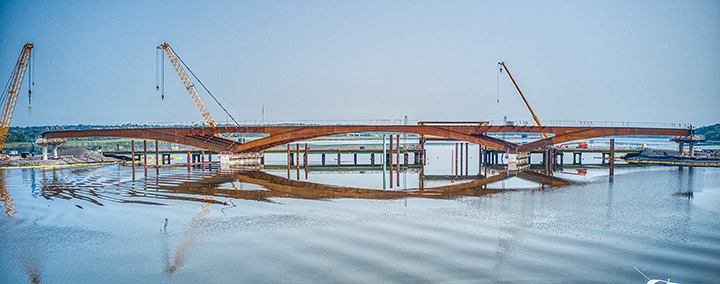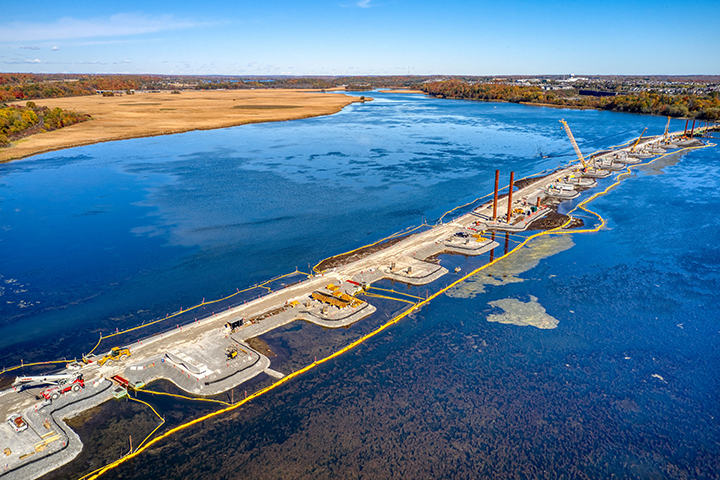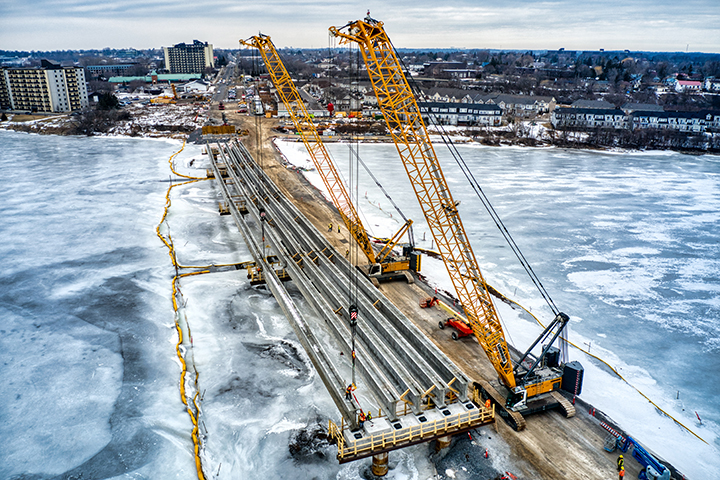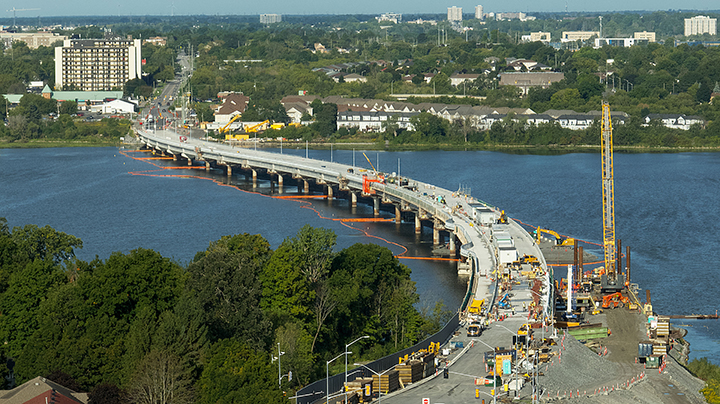TAC Sponsor Spotlight Article
By Philip Murray and Biljana Rajlic, Hatch
In the realm of contemporary infrastructure development, the Waaban Crossing (Kingston Third Crossing) stands tall as an embodiment of transformative methodologies and innovation. This great achievement, orchestrated by the City of Kingston in collaboration with Hatch, Systra, and Kiewit, not only bridges communities along the Cataraqui River but also sets a new standard with its pioneering use of the Integrated Project Delivery (IPD) approach.
The genesis of the Waaban Crossing traces back to the city’s recognition of the need for a third river crossing to accommodate growth and enhance connectivity between diverse neighbourhoods. This undertaking embraced an unprecedented IPD model, forging a holistic alliance where the owner, designer, and constructor united under a joint contract, committing to collective decision-making in the project’s best interest. Together, and despite the pandemic, this integrated team completed the 1.2 km long bridge on time and on budget.
What makes this project truly trailblazing is the implementation of IPD in a bridge construction context, a first in North America. This innovative approach incentivizes collaboration by dissolving traditional barriers between stakeholders, eliminating adversarial practices, and fostering a cohesive environment where shared goals take precedence over individual gains.
The IPD framework empowered the multidisciplinary team to reimagine and refine the bridge’s design and construction methodologies during the validation period. Notably, the project underwent a cost-saving innovations process. Structural modifications, coupled with a hybrid in-water construction approach, showcased the team’s adaptability and ingenuity in overcoming challenges to meet budgetary constraints with increased safety.
The major cost-saving innovations conceived during the validation period were:
- The approach span substructure design was simplified from V-piers (as proposed in the EA) to modified conventional vertical piers and pier caps that had a less heavy and more open appearance. 19 approach span piers each supported by two 1626 mm outer diameter steel cased concrete caissons and two piers, for the main navigation span, each supported by three 1626 mm outer diameter steel cased concrete caissons.
- Because of high steel prices, the steel approach spans were replaced by five 2.4 m high NU I type precast prestressed concrete girders with span lengths of 48 m on the west approach and span lengths of 43 m on the east approach – the largest concrete girders ever produced in Ontario. These were the longest girders that could be manufactured and delivered by road, and that could be lifted into place on-site.
- Providing a temporary trestle platform across the entire river from which to construct the new bridge was a significant cost. After considering various options, a hybrid approach using a combination of a causeway in the shallow areas, a trestle in the deeper parts, and a temporary lift bridge over the navigation channel was selected.

The arch of the main span reflected in the river

Piles and pile caps being constructed

Two cranes sitting on the temporary causeway
Beyond its financial implications, the Waaban Crossing redefines success by its holistic consideration of environmental impact. In an age where sustainability reigns supreme, this project championed a reduced ecological footprint by integrating design modifications that respected the surrounding UNESCO World Heritage Site. The new crossing, with its bike lanes and walking paths, will encourage active transportation, shorten journey time across the river by an estimated 40%, allow for expansion of existing transit routes, provide a potential emergency detour route for Highway 401 traffic, and improve access to city services. The city estimates that these benefits will reduce vehicular travel by 60 million kilometres per year and reduce greenhouse gas emissions by approximately 14,000 tonnes per year.
Wabaan Crossing also served as an engine for local economic growth, fostering collaboration with regional businesses, sourcing materials locally, and providing employment opportunities to residents within the vicinity. The city’s vision for the new bridge was to provide an iconic structure that would give their residents a sense of pride, attract tourism, and respect the natural environment in which it is built.
The IPD approach didn’t just transform the construction process; it empowered the local community, leaving a lasting positive impact far beyond the completion of the bridge. For example, the team procured more than $22.7 million of locally sourced material and contracts; utilized more than 326,000 hours of labour from workers who live within 115 kilometres of Kingston, with more than 168,000 of those hours from workers who live within 40 kilometres; secured 93 contracts with local businesses; employed 38 staff members, who moved to Kingston to work on the project; donated more than $15,000 in charitable donations to local causes and contributed over 80 community service hours; and sponsored and collaborated with Queen’s University to monitor the bridge’s performance during operation.

An overview of the bridge looking westwards
The Waaban Crossing is not merely a physical structure; it represents a paradigm shift in infrastructure development. It exemplifies the potential of parties to work together under an IPD contract to usher in an era where collaboration, sustainability, and innovation converge to create transformative infrastructure.
The city opened the new bridge to the public following a ribbon-cutting ceremony on 13th December 2022 and officially named the bridge the Waaban Crossing. (Waaban is an Ojibwe term meaning dawn or morning light.) As Kingston Mayor Bryan Paterson said at the bridge opening, “This is a moment to savour. This is a moment that we have all earned by working together.”
As the transportation landscape evolves, the legacy of Waaban Crossing stands as a testament to the power of integrated collaboration, paving the way for future projects that prioritize innovation, sustainability, and community engagement.

